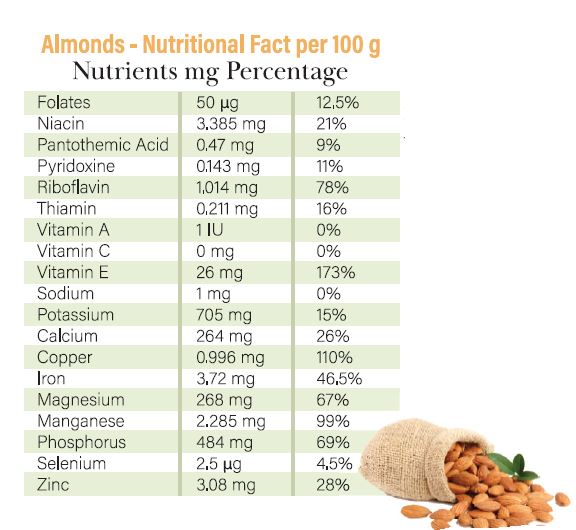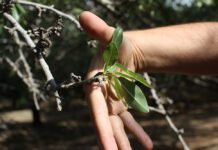As this year’s spectacular bloom is now replaced with delicate green leaves, it’s time to start the foliar testing process. Of course, the UC has created and implemented the Early Sampling Protocol (UCD-ESP) to better assess our nitrogen needs long before we notice a real problem.
Last year we witnessed a crazy March filled with turbulent storms charged with an abundance of lightning strikes. The atmospheric nitrogen that was transformed through those charges may have been a great contributor to higher than normal nitrogen numbers many of my growers experienced. The good news is, much of it went into the trees and not through the soil for potential leaching. (As I am writing this article before you’ll see it in April, I’m still praying for the same type of weather events!) In turn, on many blocks we noticed elevated levels of magnesium as well with those higher N numbers. Which brings up the next point: What about the other nutrients? What should we be looking for? Better yet, how do we fix it.
First of all, be prepared to make changes if you are spending the money to take tissue tests. What good are the numbers if you aren’t going to address the issues? If you notice manganese is low, but you are continuing to hammer zinc and boron, because that’s what you’ve always done, don’t waste the effort on the test.
Look over last year’s July numbers. If you were in the 3.0 ranges or higher, and still added a good slug of nitrogen in your post-harvest routine, you may be able to reduce your early N shots this Spring. Analyze your early N numbers and make those adjustments. Rank growth opens a whole new Pandora’s Box of issues that we can discuss in a later issue. Smaller, more frequent shots will ensure a better, more constant saturation in the root zone to match tree demand. Of course, that requires more attention to the logistical details, but many companies are now offering wonderful fertigation systems to make that process easier.
Know Your Demand
A good way to develop your skills is to study your nutrient demand curves and match the application with the potential uptake. For almonds, here is a good website location to get started: http://ucanr.edu/sites/scri/Crop_Nutrient_Status_and_Demand__Patrick_Brown/Variability_Assessment/
You’ll notice the graphs of the leaf concentrations. This gives us a baseline of how levels fluctuate throughout the season. N, P, Zn and Cu start high and taper off throughout the season. Ca and Mg continue to rise throughout the season, yet we rarely continue with our applications of those nutrients well into July. K will rise slowly from April to May, normally takes a dip and then it’s a steady rise from June to July when things really heat up. Can we say evapotranspiration? As photosynthesis is supercharged, Iron goes ballistic in the tissues June through July, or at least it should…
Now take all that data and store it in the back of your mind. The real test will be comparing previous years soil test, to tissue tests and yields. That’s where the rubber meets the road. Did previous applications give you superior results? When did you do those applications? What nutrients did you combine? Let’s look at a typical almond nutritional profile in a handful of nuts we eat.
You’ll notice potassium (K) is at listed at 705 mg. We know they take up a lot of K. But did you know that almonds are a great source of magnesium for us at 268 mg? That’s more than a third of K’s amounts. And who knew almonds provided 484 mg of phosphorus! Almost 70 percent of our daily intake requirement can be met in a handful of almonds. How many of you as farmers address enough P throughout the course of the season? And how many make sure it’s delivered or at least quickly weathered in the right form as orthophosphate?
Feed Them What They Can Use
Remember, a plant can’t drink polyphosphate. If your tissue tests are low in early P, you better address that issue quickly. And in cold and wet soils, it has to be ortho. Poly P takes too long to break down in the spring. Almonds are also a good source of Calcium, 264 mg in a serving to be exact. Now think back to your agronomy and realize calcium is not mobile in a plant. When it gets assimilated into a cell, it does not come back out if new growth needs it. Plants need a constant supply of calcium throughout the season. With that much going into the nut, and tissue calcium levels rising throughout the season, do we apply enough all year long? Probably not. If our water is laden with bicarbonates, or we’ve over applied a non-plant ready P source, we have even less available calcium in season as demand increases.
Manganese levels remain fairly constant in the tissues throughout the season. But what do we do with the ability to deliver manganese if we use one of its greatest disruptors, glyphosate, in summer weed control? You’re going to kill your weeds. Why not apply some of your Mn upstairs in summer mite sprays? Be diligent and think of the action/reaction response we always talk about. You may have been using the right products all along in the wrong places at the wrong time.
You as a farmer have so much to deal with on a daily basis, keeping track of how your nutrition is assimilated often gets overlooked. Many of our fertilizer manufactures create blends for us hedging our bets with a blanket approach to micronutrients. Since micronutrients are used in much smaller levels than the big boys, they can be addressed in much smaller amounts. But when they become a limiting factor, you have to be prepared to make changes to ensure they get applied correctly, with the 4 R’s, in a timely fashion. Take a test and use them as a tool to make changes to your program. Being proactive with your crop advisors will give you much better chances of improving yields. Matching nutrient delivery to nutrient uptake will not only improve those chances, it’ll keep you from applying unnecessary nutrition that could block the uptake of something else. Take those tissue tests, read them, assess them, compare them to previous seasons yields and then most importantly, make adjustments. We all know, doing the same thing over and over again expecting different results is futile. Your crop is too valuable to not sweat the small stuff. Tissue tests can keep the small stuff from becoming big problems.







![shutterstock_1145180888-[Converted]](https://wcngg.com/wp-content/uploads/2020/04/shutterstock_1145180888-Converted.jpg)









